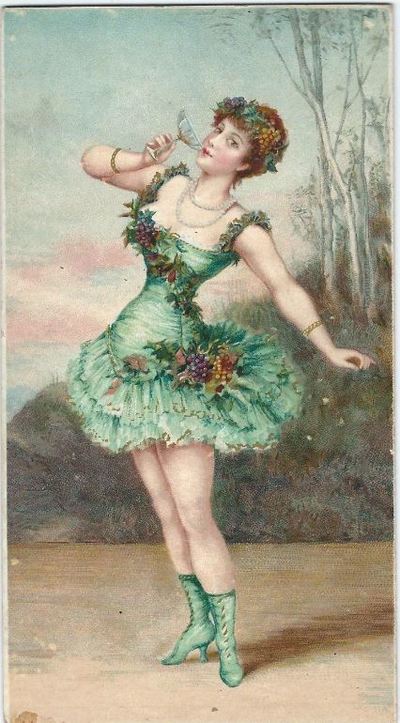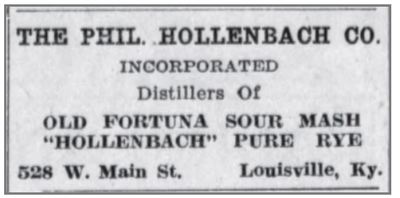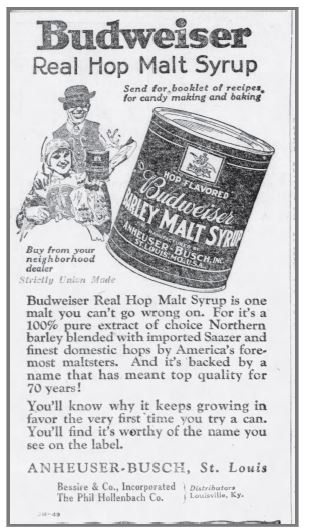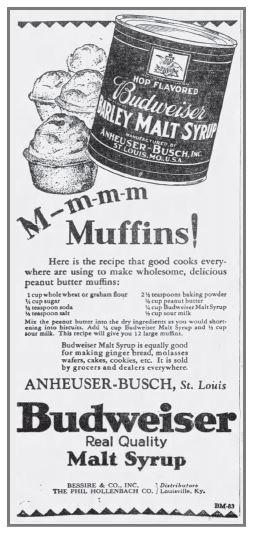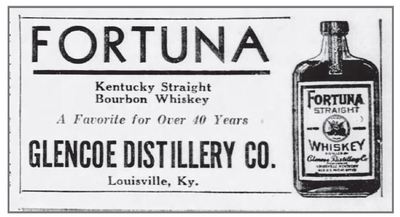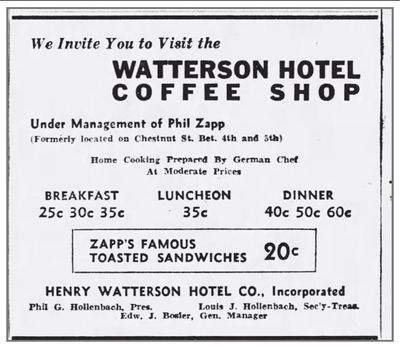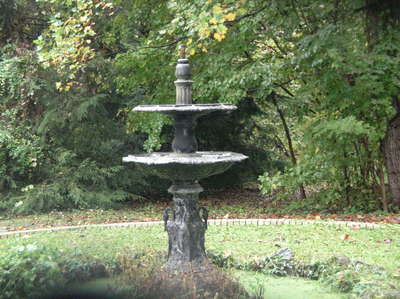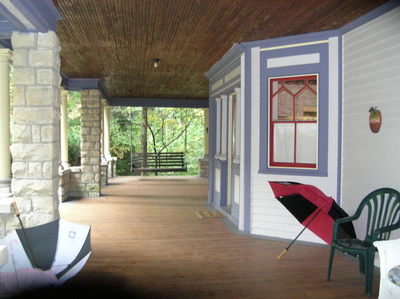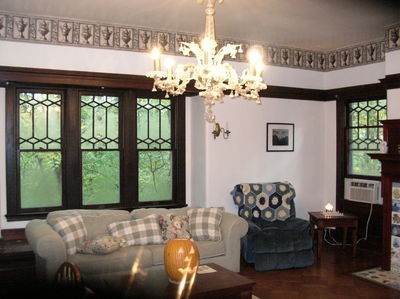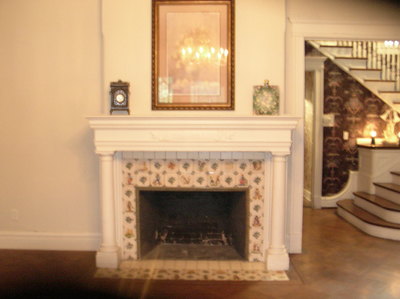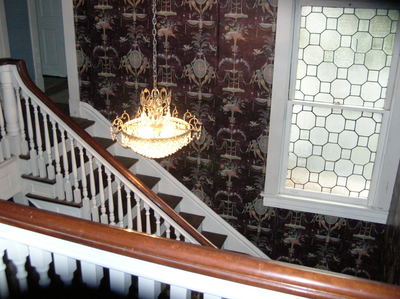The Beeches: Later Years
 Ca. 1989 color photo of The Beeches taken by historian Carolyn Brooks for the Central Avenue Historic District nomination to the National Register of Historic Places.
Ca. 1989 color photo of The Beeches taken by historian Carolyn Brooks for the Central Avenue Historic District nomination to the National Register of Historic Places.
After Mary Johnston died in 1966, the house was owned very briefly by Otis and Virginia Herdt "Gin" Chadoin.
Steve Conn, who grew up next door at The Gables, remembers the aftermath of Mary Johnston's death:
Steve Conn, who grew up next door at The Gables, remembers the aftermath of Mary Johnston's death:
The Hollenbach & Buckler Years
On New Years Eve 1967, The Beeches sold. And in 1968, after spending nearly a year renovating the 65-year-old home, four generations of the Hollenbach family moved in. Janet Lowell Walker described the remodeling process and the end result in the August 7, 1969 Courier-Journal:
The Beeches, stately old home in suburban Pewee Valley, where the late Annie Fellows Johnston lived ... has been given a new lease on life. It's been splendidly remodeled.
Mr. and Mrs. Philip Hollenbach and their daughter and son-in-law, Mr. and Mrs. William Buckler, have purchased the Beeches and moved four generations of their family into this literary shrine, including Hollenbach's mother, Mrs. Louis Hollenbach Sr., and the Bucklers' two little sons, Joseph, 4, and Philip, 4 months ...
... The famous author died in 1931, but her stepdaughter, Miss Mary Johnston, remained at the Beeches alone, devoted to her friends, her garden, her painting, her music, until she died three years ago.
Then the Beeches faced the predicament of many interesting but out-of-date old homes, deterioration and neglect. It's very size made it formidable to maintain in an era of servantless living.
But Kathy Hollenbach Buckler had always wanted to live in a big old home in Pewee Valley. Her father, prominent Louisville and Oldham County civic leader and drama enthusiast, always had adored the Beeches. So the families held a council, took a deep breath and plunged in.
"Built like a fort" is the way Hollenback describes the sturdy mansion and its stone foundations. "It nearly drove the electricians wild ... Those thick walls and steel I-beams over every archway."
The work progressed over one maddening, very expensive year. It included painting, inside and out ("was it thirsty"), new wiring, all new plumbing, drywall ceilings in every room, remodeled kitchen and family room, a three-passenger elevator, walls moved, fireplaces closed or restored, bathrooms created out of closets, closets created out of hallways, a three-car garage added, arbors built and trees trimmed in the yard. And in the driveway a raised circular garden for Bill Buckler's green thumb.
The face-lifting is fabulous. Rooms are luminous and filled with family antiques. An exquisite chandelier shines down the dramatic open stairwell to a wall of paintings done by Kentucky artists, all friends of the family.
If the rest of the house is elegant traditional, the kitchen and family room are groovy modern. The dingy and sepulchral old kitchen has been turned into a magical room which pleases even a demanding gourmet cook like Hollenbach.
The adjoining paneled family room is where the four generations focus. Here are lots of comfortable chairs, big work table, television, washer and dryer, telephone, elevator, desk and -- beloved of small boys -- a water cooler with hot water attachment for "Gramps" cup of coffee.
Upstairs, 87-year-old Mrs. Louis Hollenbach is in the lovely bedroom where Mrs. Johnston used to do all her writing. A middle room has been paneled and equipped with rows of shelves for an upstairs library.
Hiding in a big closet is a refrigerator where the family keeps snacks and iced drinks. Master bedrooms, Joseph's room and guest room are all on the second floor. Up under the eaves near the attic is Kathy Buckler's sewing room (formerly Miss Johnston's painting studio) where she turns out expertly tailored fashions for the whole family.
Talent spills out over this family. Great-grandmother Hollenbach goes down to the music room almost every morning for several hours to practice the piano.
Phil Hollenback and his wife, Margaret, are practically a fixture at the Little Colonel Community Playhouse in Pewee Valley.
He has been the director for 12 years, and she's active in ticket sales and membership drives.
Buckler, who is a theoretical physicist, has published numerous scientific pamphlets. He and his wife are well-known folk dancers...
... But modern and well-equipped as the Beeches now is, she must still live with her past, like any other great heroine. Like the morning last spring when a taxicab pulled slowly into the driveway. An elderly lady got out and came up to the door. She had ridden out from Louisville to fulfill a childhood dream.
"I'm from Selma, Alabama," she explained courteously, "and I just couldn't come to Louisville to visit my family without coming here to see the Beeches. I just loves those stories as a child, those 'Little Colonel' books. Do you think I might just take a photograph of it, please?" ....
Ann Montgomery also covered the Hollenbach/Buckler renovations in the 1974 Bicentennial edition of the Call of the Pewee:
... After (Annie Fellows Johnston's) death in 1931, her stepdaughter, Miss Mary Johnston, known in the area for her artistic talent, stayed on .... until her death ... in 1966. Then it stood vacant until New Year's Eve in '67, when the present owners, Mr. and Mrs. William Buckler, acquired it. They spent several months remodeling before moving in. All eleven rooms were re-papered, new ceilings were put in, a modern kitchen was made out of the former butlers pantry, and circle drive were added. While this was being accomplished, Kathie Buckler made draperies for all the many windows.
Kathie and Bill Buckler's three young children, Joseph 9, Philip 5, and Borgia 1, have plenty of space to roam., both inside and out ... Eventually the Bucklers plan to make the uniquely panelled third floor attic into a recreation area for the children. It originally housed servants...
... The home has fireplaces in every room, two of which have been redone by Bill with tiles gathered from all over the world...
... The grounds still have the cottage in back, that was originally the gardner's home, as well as thousands of bulbs, mainly daffodils. Bill's summer hobby is replanting these from the garden, which had 360 rows of daffodils, each 40 feet long! He's replanted many in a more natural setting in the wooded part of the acreage. There are many lily of the valley beds that bloom every year ....
... After (Annie Fellows Johnston's) death in 1931, her stepdaughter, Miss Mary Johnston, known in the area for her artistic talent, stayed on .... until her death ... in 1966. Then it stood vacant until New Year's Eve in '67, when the present owners, Mr. and Mrs. William Buckler, acquired it. They spent several months remodeling before moving in. All eleven rooms were re-papered, new ceilings were put in, a modern kitchen was made out of the former butlers pantry, and circle drive were added. While this was being accomplished, Kathie Buckler made draperies for all the many windows.
Kathie and Bill Buckler's three young children, Joseph 9, Philip 5, and Borgia 1, have plenty of space to roam., both inside and out ... Eventually the Bucklers plan to make the uniquely panelled third floor attic into a recreation area for the children. It originally housed servants...
... The home has fireplaces in every room, two of which have been redone by Bill with tiles gathered from all over the world...
... The grounds still have the cottage in back, that was originally the gardner's home, as well as thousands of bulbs, mainly daffodils. Bill's summer hobby is replanting these from the garden, which had 360 rows of daffodils, each 40 feet long! He's replanted many in a more natural setting in the wooded part of the acreage. There are many lily of the valley beds that bloom every year ....
About the Hollenbachs: The Glencoe Whiskey Fortune
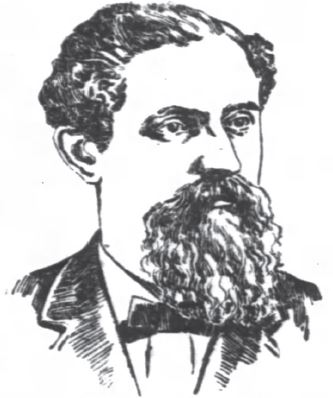 Pen and ink portrait of Philip Hollenbach from the June 21, 1896 Courier-Journal
Pen and ink portrait of Philip Hollenbach from the June 21, 1896 Courier-Journal
Philip Hubbuch Hollenbach was the grandson of Phil Hollenbach (December 4, 1851-March 21, 1929), who at one time owned Louisville's Glencoe Distillery. "History of Kentucky, Edition 8a" by J.H. Battle, W.H. Perrin and G.C. Knifflin" (F.A. Battey Publishing Co., 1888) notes:
PHILIP HOLLENBACH was born in Germany December 4, 1851, and came to the United States in 1869, when eighteen years of age. He located in New York City, where he found employment as a clerk. In 1870, he went to Alabama, where he engaged in horticulture, making a specialty of grape culture, in which he was successful, and the following year he removed to Louisville.
In 1877, he and his brother, Louis, founded a wholesale liquor and wine company known as Hollenbach Bros. at 193 Market Street. Five years later, in 1882, the company got into the whisky blending business with the Stitzels, who owned Glencoe Distillery at 2450 Broadway. Old Fortuna and Glencoe were their main brands and Hollenbach promoted them widely in ads and on trade cards. About 1885 Phil's brother Louis left the partnership and moved to Chicago, where he went into the wholesale and retail whiskey business and became the city's exclusive dealer of Glencoe brands.
In July, 1902, the company incorporated in Kentucky as "Phil Hollenbach & Co." with four stockholders: Phil J. Hollenbach, President; Edward Oesterritter, Vice President; Louis J. Hollenbach (Phil's son), Secretary-Treasurer; and John Hattemer, and purchased the Glencoe Distillery outright. In 1911, they moved their corporate headquarters and wholesale liquor operation to 528 W. Main Street.
Passage of the 18th Amendment shut Glencoe distillery down in 1920, but the Phil Hollenbach Company survived. They diversified and sold non-alcoholic brews made by Anheuser-Busch in St. Louis -- ginger ale, Grape Bouquet and a "near beer" version of Bud; malt syrup for baking and candy making; and Angostura bitters as a patent medicine. But although the distillery was no longer making whisky, Glencoe was still selling it. The January 1, 1937 Courier-Journal ran an interview with Phil's son, Louis, who had taken the distillery's reins when his father died in 1929. During the interview, Louis explained how the firm made it through 13 long years of prohibition and came out the other side smelling like a rose:
..."When prohibition closed the doors of the distilling industry, Glencoe was fortunate in having a large reserve of its stock in bond. As a result, the company was permitted to stay in business, supplying its brands to the drug trade during the entire prohibition era.
"In 1929 when the distillation of whisky was resumed under special Government allocations, the Glencoe Distillery Company participated with several other distilleries in rehabilitating one of the four remaining distilleries in Kentucky," he continued.
"Repeal found the company in an advantageous position. It was one of the few distilleries in the Unites States which had a stock of two, three, and four-year-old whiskies on hand at the time of the repeal, and doubly fortunate in having experienced personnel ready to meet the increased demand. The greater portion of the men employed at the Glencoe plant and the majority of them have been associated with the company since its incorporation..."
Hollenbach Company Ads During Prohibition
In 1935, Glencoe built a modern new distillery in Shively at Cane Run Road to produce their Glencoe, Fortuna, Fern Grove and Fern Brook brands. Bourbon was booming and just six months after the new plant opened, they announced plans to expand and double their production. Nine years later, during World War 2, they sold the distillery to National Distillers and McKesson & Robbins, Inc. The sale was announced in the April 8, 1943 Courier-Journal:
Glencoe Distillery
Is Sold to National
_____________
Price Believed to Be Over $3,000,000;
Sale Leaves Few Independent Firms
Purchase of Glencoe Distillery Company by National Distillers Products Corporation and McKesson & Robbins, Incorporated, through acquisition of outstanding stock was announced yesterday by attorneys representing the buyers.
Although the sale price was not revealed, it was estimated by one source close to the deal that the consideration was well in excess of $3,000,000 ... the distillery had 37,858 barrels of whiskey in its warehouses as of December 31, 1942. Restriction of production as a result of the war has turned bulk whisky into "liquid gold," as one trade source described it.
Facilities of the distillery were being utilized exclusively for production of alcohol for war purposed. The purchasers said that Louis J. Hollenbach, Jr., would continue as distillery superintendent...
... Glencoe was chartered May 29, 1902 by Phil J. Hollenbach, father of the present president, Louis J. Hollenbach, Sr. ...
... On its organization, Glencoe purchased the property of Stitzel Brothers and sold whiskey under its own brands. Though dismantling its distillery during prohibition, Glencoe continued supplying medicinal whisky. Rehabilitating its distillery in 1929, Glencoe produced whisky amounts allotted to it from 1930 to 1933, the year of repeal.
In the spring of 1935, Glencoe constructed a new distillery on Cane Run Road and started production that year. The bottling plant was moved to the Cane Run Road site in September, 1939.
The company's brick distillery, erected on an 18-acre tract of land, has a capacity of 100 barrels each eight-hour day. A brick bottling plant 80x100 feet, adjoining the distillery, has a capacity of 1,500 cases daily. Separate buildings accommodate the still house and revenue office and boiler room. Three warehouses have a capacity of 60,000 barrels. Deep wells provide limestone water.
The plant's value, aside from whisky inventory, has been estimated at $350,000... the company has marketed most of its own whisky in contrast ... to many independents which sold much of their production in bulk. Brand names are Glencoe, Fortuna and Fern Brook.
Officers of Glencoe included Edward F. Konz, vice president; Philip J. Hollenbach, executive vice president; Edward C. Oesterritter, vice president (editor's note: this appears to be the son of Edward M. Oesterritter, who served as vice president when the company was incorporated in 1902. Edward M. died in 1938 after falling through an elevator shaft at Glencoe's Cane Run plant and contracting pneumonia); Louis J. Hollenbach, Jr., treasurer; and Walter J. Doerting, secretary. Officers comprised the company's directorate...
... Cash value of the rather limited number of Glencoe stockholders was not revealed, but one report was that $100 par shares of common approached a value of $4,000 each...
Glencoe Ads After Prohibition
In the 1960s, declining bourbon sales led National Distillery to begin closing their Louisville plants. By the late 1970s, they had left Jefferson County entirely and moved all their production to Frankfort, Ky.
While the Glencoe distillery on Cane Run Road stands in ruins today, the Phi Hollenbach Company's former headquarters on W. Main Street is now the site of the Evan Williams Bourbon Experience in the heart of Louisville's Whiskey Row.
Another building associated with the Hollenbach company also stands at 539 W. Market Street, across from the Hall of Justice. It was purchased in 1928 by the Portland Building and Loan Association, later Portland Federal. They moved their corporate headquarters to 200 W. Broadway ca. 1978, and in 1980, the building was purchased and restored by Walter J. Swyers for law offices. The Phil Hollenbach Co. was located there for some years before moving their headquarters to Main Street.
Another building associated with the Hollenbach company also stands at 539 W. Market Street, across from the Hall of Justice. It was purchased in 1928 by the Portland Building and Loan Association, later Portland Federal. They moved their corporate headquarters to 200 W. Broadway ca. 1978, and in 1980, the building was purchased and restored by Walter J. Swyers for law offices. The Phil Hollenbach Co. was located there for some years before moving their headquarters to Main Street.
Philip Hubbuch Hollenbach Family
Louis J. Hollenbach, Sr. (1880- Oct. 17, 1954), who took over the presidency of Glencoe Distillery when his father died, married Kathryn Hubbuch (1882-1971) on October 19, 1904. Phil was the second of their three children:
- Alice Louise Hollenbach Eigelbach (August 1, 1905-March 22, 1988), who married twice and was living in Ft. Lauderdale, Fla., when she died;
- Philip Hubbuch "Phil" Hollenbach (June 9, 1908-September 24, 1986), who purchased the Beeches in 1967 and directed the Little Colonel Players for many years; and
- Louis Jacob Hollenbach, Jr. (February 3, 1915- September 10, 1973), who was treasurer of Glencoe Distillery when it was sold in 1943; was the father of Todd Hollenbach, III, who served as Jefferson County Judge from 1970-77; and was the grandfather of Todd Hollenbach, IV, who served as Kentucky's 37th State Treasurer from 2008-2014.
The Louis Hollenbach, Sr., family lived at 3825 W. Broadway near their distillery for many years, but by 1930 had moved to 1805 Windsor Place in the Highlands.
As Louis's oldest son, Phil was groomed for the family business. He graduated with his first degree from St. John's College/ Fordham University in 1930. On January 11, 1931, his engagement to Margaret Dyer was announced in the New York Times:
Announcement has been made of the engagement of Miss Margaret Mary Dyer, daughter of Mr. and Mrs. Martin Dyer, of Bedford Park, N.Y., to Phillip Hubbuch Hollenbach, son of Mr. and Mrs. Louis Hollenbach of Louisville, Ky. Miss Dyer was graduated from the Convent of Mount St. Vincent. Mr. Hollenbach was graduated from St. John's College (part of Fordham University) with the class of '30. He is with the Fidelity Title & Guaranty Company in Mt. Vernon, N.Y. He is the grandson of the late Col. Phil Hollenbach of Louisville, Ky.
Before they got married, Phil earned a second degree at Columbia University. Two years after their engagement was announced, the wedding took place on June 20, 1933. It was covered by both the New York Times and the July 4, 1933 Courier-Journal:
The marriage of Miss Margaret Mary Dyer to Mr. Phillip Hubbuch Hollenbach of Louisville took place in the Church of Our Lady of Mercy in Fordham, the Bronx, with a nuptial high mass. The bride was given in marriage by her father. The marriage was performed by Rev. John J. Dyer, an uncle of the bride...
... The bride ... is the daughter of Mr. and Mrs. Martin C. Dyer of 2958 Decatur Avenue, Bedford Park, the Bronx ...
... The ceremony was followed by a reception at the Arrowhead Inn, Riverdale-on-the-Hudson. The bride is a graduate of the College of Mt. Mercy St. Vincent, and Mr. Hollenbach is a graduate of Fordham University.
While Phil may have expected a position in the company's beverage business, his grandfather's death in 1929 threw a wrench into any aspirations he may have had along that line. Instead, he was asked to go back to school and learn the hotel business. His father, aunt and uncle Philip G. Hollenbach had inherited the Watterson Hotel at Fourth and Walnut (now Muhammed Ali Boulevard), and they needed Phil's help to turn it around. The distillery directorship would later go to his little brother, Louis, Jr.
By 1935, he was working as the Watterson Hotel's food department manager. Phil reminisced about his experiences in the August 28, 1970 Courier-Journal:
... Hollenbach's cooking stint at the Watterson began when his grandfather, also named Philip, who had owned the hotel died, and left the hotel to his sons and daughter. It had been rented to a chain and badly needed refurbishing and reorganizing. "My dad asked me to go to Cornell's Hotel School, which I did," said Hollenbach.
Since he already had taken history and other basic courses while getting degrees at Fordham and Columbia, he took the whole hotel course in one year, majoring in foods.
He remembers one exam in the food course in which students had to plan meals for a week for all the restaurants in the New Yorker Hotel and for wedding receptions and other private parties. "I had three hours to do the whole thing, and got a 100 percent," he recalled with pride.
Hollenbach ran the Watterson's kitchen from about 1931* to the 1937 flood, when the hotel overflowed with refugees from the rising Ohio. "They would meet someone in the lobby who would invite them to share their room, and before you knew it, we had four families in one room," with no heat, light or power.
"I cooked on a four-burner, coal oil stove for those 1,200 people," and soon after that experience, he decided to leave the hotel...
*(Editor's note: Phil and his wife were living in Ithaca, New York in 1934, where his occupation was listed as graduate student, and he was presumably enrolled in Cornell University's hotel program. The first record of his employment at the Watterson is the 1935 Louisville City Directory.)
The hotel was owned by one of more members of the Hollenbach family from 1930 until 1951.
Involvement with the Arts
Phil proved more bon vivant than businessman. Outside of owning a farm in Prospect, his only other real business venture during his lifetime was Gifts, Inc., a shop he owned with a cousin in Middletown. Instead, Margaret and he devoted their time to the local arts scene and other civic projects. They were active members of the Arts Club of Louisville, which had moved its headquarters to the Watterson Hotel in 1935. Phil also served as president of the Oldham County Community Chest in 1946.
But the theater was their abiding passion. Before directing the Little Colonel Players, Phil was heavily involved with the Little Theatre Company, a community group that performed at the Belknap playhouse on the University of Louisville campus. Besides winning accolades as an actor -- his many performances earned him two "best actor" medallions, one for "Brief Moment" and one for the Charles Laughton role in "Payment Deferred" -- he directed plays and was elected president of the group in 1940. Margaret served as its executive secretary for 15 years. He was also a founder and served as president of Louisville Children's Theatre and remained active with that group after taking on the director role for the Little Colonel Players.
Joan Kay, writing for her "Speaking of People" column, provided a glimpse into Phil's busy volunteer/social schedule in the October 10, 1964 Courier-Journal:
Focus on Phil Hollenbach
With his feet on at least four stages, Philip H. Hollenbach may have trouble keeping his balance this year.
After a 10-week tour of Europe with his family, he came home to fill out a busy schedule as president of the Arts Club, president of the Louisville Children's Theatre (which opened its season this month with "Heidi"), director of the Little Colonel Players, and a member of the board of Belknap Theatre on the University of Louisville campus.
The Little Colonel Players, who recently created a theatre out of a grocery store, are hoping to have a gala opening of their new quarters on November 20.
Their first play, "A Likely Tale," is "a really hilarious comedy," says Mr. Hollenbach -- "as funny as 'You Can't Take It With You.'" The English play has just been cast.
As for the Arts Club, he has appointed committees to line up its weekly programs of art, music, drama and dance.
By request of the members with young children who find it hard to come out every Sunday night, the dinner meetings will alternate this year between Saturday and Sunday.
Tonight an informal Leap Year dance is planned -- "we thought we'd give the girls another chance," said the president.
Coming up November 1 is a pre-election party with a program on "Mistresses of the White House." Members will give readings of former first ladies as women pose on the stage in costumes of the period.
A Shakespeare night with readings and Elizabethan music is planned for November 22, and members are working on an operetta for Christmas.
The 10-week European tour mentioned in the article was a wedding gift to Margaret and Phil's only child, Katherine, who had married University of Louisville physics and electronics professor William Harold Buckler on March 30, 1964.
The Little Colonel Playhouse
 Phil Hollenbach directing "Quality Street" in 1959, while the Little Colonel Players were performing at the Louisville Fresh Air Home/Valley Camp. Photo courtesy of the Little Colonel Players.
Phil Hollenbach directing "Quality Street" in 1959, while the Little Colonel Players were performing at the Louisville Fresh Air Home/Valley Camp. Photo courtesy of the Little Colonel Players.
Hollenbach directed the Little Colonel Players' first full-length show in 1958, the year the group opened the theater at the Louisville Fresh Air Home/Valley Camp. Today, players board member William Baker credits him with the group's success. "He was involved with LCP from the beginning, in working with Pewee Valley Women’s Club," Baker says. "He was the one with the theater knowledge that helped get the Players off the ground back in the late '50’s."
During his 16-year stint with the players, he directed a total of 43 shows and appeared onstage 15 times. Joan Kay's February 16, 1968 Courier-Journal column,"Speaking of People," reported that he was playing the role of Tomaso Savelli in "Two Dozen Red Roses." Kay noted that Hollenbach's acting roles with the Little Colonel Players had mainly been born of necessity --... "when we didn't have somebody right for the part." Stepping in as the director for "Two Dozen Red Roses" was Matthews Fletcher, postmaster of Pewee Valley and namesake of his great aunt, photographer Kate Matthews.
Kay's story also mentioned Hollenbach's role in getting teens interested in joining the Little Colonel Players:
... The Pewee Valley Woman's Club, which founded the Little Colonels, asked Hollenbach to organize something for teen-agers -- "there was no bowling alley or anything in the area at that time.
"I've been directing for ten years now -- we have a real nice group of teenagers." ...
Phil bowed out as director in 1974. He was named the Little Colonel Players' Director Emeritus in August 1984. Shortly before her death in 1973, his wife, Margaret, was also recognized for her many years of service.
Gourmet Chef
Phil never forgot the lessons he learned slaving over that oil-burning stove at the Watterson Hotel. He was a well-known epicure and gourmet chef, planned and prepared many of the meals for the Arts Club and loved to entertain. For Pewee Valley's Centennial Celebration, Lillian Marshall featured a dinner he served at The Beeches in the August 9, 1970 Courier-Journal & Times Sunday Magazine. Earlier in the year, Marshall published his mocha torte recipe and noted in her January 21 column that Phil was serving as chairman of the Arts Club's gourmet committee:
...Hollenbach's ... group stages ... a gastronomic adventure every month or two, and in the three years they've been doing it, their dinners have one of the most looked-forward-to affairs of the club ...
The August 28, 1970 Courier-Journal interview talked about his love of preparing fine food for guests:
... At the Beeches, which is home for both the Hollenbachs and Bucklers, Kathie Buckler cooks most of the family meals and her father takes over for dinner parties. "He'd rather cook for a big crowd than three or four," said his daughter.
But even for family dinners, "he's always got his finger in the pot -- stirring gravies. You just can't keep him out."
Favorites of hers among his specialties are beef stroganoff and chicken tetrazzini.
"I love Italian food mainly," said Hollenbach, but also Oriental. "I'm also one of those people who can't eat mashed potatoes twice in the same month" ....
... Part of the fun in eating new dishes at restaurants or at other homes is analyzing the ingredients. "I get so enraged sometimes when I eat something I can't tell what's in it." ....
Death
 Margaret and Phil Hollenbach. Photo courtesy of the Little Colonel Players.
Margaret and Phil Hollenbach. Photo courtesy of the Little Colonel Players.
Phil's mother, Kathryn, died in 1971. Margaret died July 24, 1973. The Courier-Journal ran her obituary the next day:
Mrs. Philip Hubbuch Hollenbach, 65, of the Beeches at Pewee Valley, Ky., died at 7 p.m. Tuesday at National Health Enterprises Northfield Manor Nursing Home.
She was the former Margaret Mary Dyer and a native of New York City. She was a member of St. Aloysius Catholic Church at Pewee Valley, the Arts Club of Louisville, the Altrusa Club and the Little Colonel Players, from which she just received an award for outstanding service. For 15 years she was executive secretary of the Little Theatre Company, under Boyd Martin. She was also a member of the Queens Daughters, the Auxiliary of Our Lady of Peace Hospital and the Oldham County Homemakers.
Survivors include her husband; a daughter, Mrs. William H. Buckler, of Pewee Valley; and two grandchildren (editor's note: Joseph Spencer and Philip Robert Buckler). She was the aunt of Todd Hollenbach, Jefferson County Judge.
Phil remarried on March 12, 1975. His second wife was Blanche Hanratty Knoebel, a widow who was three years older and a member of the Arts Club. Unfortunately, the marriage didn't last long. She died on May 22, 1977.
Phil, himself, made his final curtain call on September 24, 1986:
Theater
Founder
Hollenbach
Dies at 78
Philip H. Hollenbach, who had long been active in local theater, died yesterday at Baptist Hospital East. He was 78.
Hollenbach, who lived in Pewee Valley, was a retired farmer and former president of Gifts, Inc. in Middletown.
He was past president of the Arts Club of Louisville and a founder of the Louisville Children's Theater. He was also a former director of the Little Colonel Players in Pewee Valley and had been a member of the old Players Club of Louisville, which merged with the Alumni Players in 1932 to form the Little Theater Company.
Hollenbach was also a member of the Pendennis Club.
Survivors include his daughter, Mrs. William H. Buckler; a sister, Alice Louise Eigelbach of Ft. Lauderdale; and three grandchildren....
1989 Photos of The Beeches from the Central Avenue Historic District Nomination to the National Register of Historic Places
Later Years
 William H. Buckler is buried at St. Aloysius Cemetery in Pewee Valley.
William H. Buckler is buried at St. Aloysius Cemetery in Pewee Valley.
After the deaths of her grandmother, mother and father, Kathie and her husband, Bill, continued to live at The Beeches, where they raised their three children. In 1989, The Beeches was placed on the National Register of Historic Places as part of Pewee Valley's Central Avenue Historic District.
Bill Buckler died on March 30, 1997. His obituary ran in the Courier-Journal on April 1:
WILLIAM HAROLD BUCKLER, 61, died Sunday at his home. He was a native of Lanesville, Ind., an assistant vice-president for United Mercantile Agencies Inc., a Marine veteran of the Korean War, a member of the Kentucky Bar Association and a former member of Arts Club of Louisville and the Filson Club. Survivors: his wife, the former Katherine Hollenbach; sons, Joseph S. and Philip H. Buckler; a daughter, Borgia K. Geoghegan; a brother, C. Robert Buckler; sisters, Mary Jane Duggins and Elizabeth Ann Browning; and a grandson. Funeral: 10 a.m. Thursday, St. Aloysius Catholic Church, Pewee Valley. Burial: church cemetery. Visitation: Ratterman's, 3711 Lexington Road, 7-9 p.m. Tuesday and 11 a.m. - 1 p.m., 3-5 and 7-9 p.m. Wednesday. Memorial gifts: National Kidney Foundation.
After his death, Kathie sold The Beeches to Dr. Stephen Applegate, of The Locust. And like her father, she remarried. Her second husband was Stewart Shacklette. She died on Christmas day in 2014:
Shacklette, Katherine Hollenbach (Buckler), 72, passed away peacefully on Christmas Day at Park Terrace Rehabilitation Center.
Katherine was a graduate of Spaulding College and served on numerous boards and charities throughout her lifetime. She was heavily involved in the Oldham County 4-H program, the Oldham County Fair Board, the Arts Club of Louisville, and the Kentucky Dance Institute.
Preceded in death by her parents, Philip H. and Margaret Hollenbach, her husband, William H. Buckler, and step-son Darren Shacklette.
Survived by her husband, Stewart Shacklette; her children, Joseph Buckler (Melanie); Philip Buckler (Kris); Borgia Walker (Ben); step-children Troy Schwartz (Dawn); Craig Schwartz; Michael Shacklette (Lisa); Jerry Lee Shacklette; 11 grand-children; and one great-grandchild.
Funeral services will be 1 p.m. on Tuesday at Ratterman Funeral Home located at 12900 Shelbyville Road. Visitation will be 2-8 p.m. Monday and on Tuesday from 10 a.m. - 1 p.m. with burial at Calvary Cemetery.
The entire family -- other than Phil's grandparents and William Buckler -- is buried at Calvary Cemetery in Louisville.
Photos from the Applegate Years
The Applegates owned The Beeches until 2011, and maintained it but never lived in it. It has since been beautifully renovated and updated by the new owners.
Related Links:





